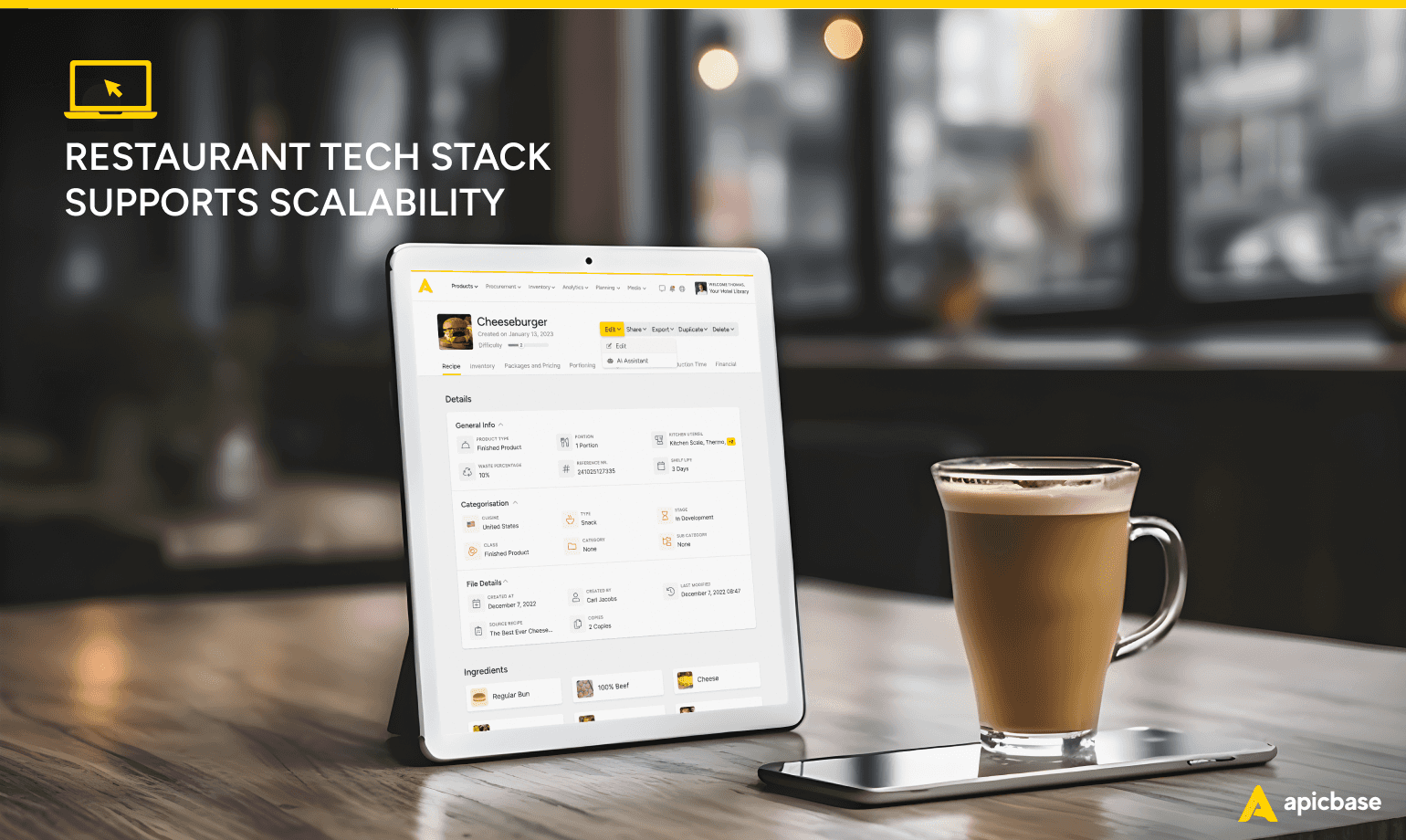Running a multi-unit restaurant business is a complex operational challenge. As the number of locations grows, maintaining high standards across the board becomes more difficult. Without the right restaurant tech stack in place, your business will struggle to maintain control and might not reach its full potential.
With 96% of restaurants planning to expand, operators are looking for the best software to manage BOH operations like inventory, recipes, production, and scheduling. But building the right tech stack to support scalability is easier said than done.
This article explores the primary problems faced by multi-site restaurants and how the right technology can solve them, focusing on the best tech solutions for back-of-house (BOH) operations.
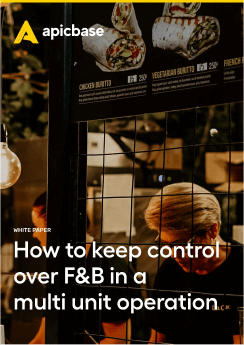
How to Keep Control Over F&B in a Multi Unit Operation
Cost control for multi location restaurants is crucial for profitability, yet you can’t be everywhere at once. Here’s how to stay in control of the back of house.
3 Key Challenges of Multi-Site Restaurant Technology
Using software to manage operations across multiple sites can streamline and simplify complex processes. However, this approach also presents unique challenges.
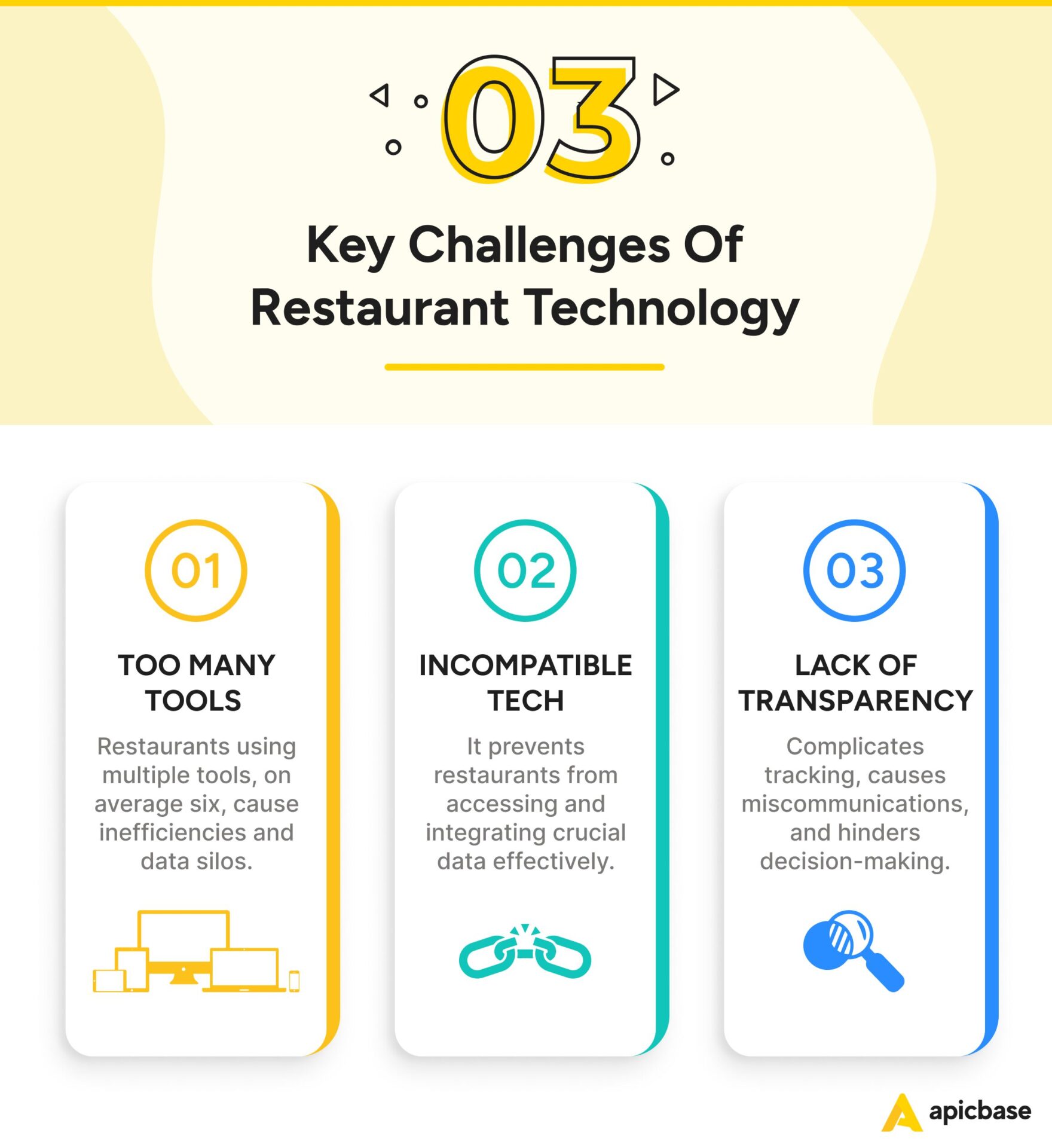
Too many tools
Over the past decade, the number of digital tools available to restaurants has exploded. Many restaurants adopt multiple single-use tools to solve specific problems, without considering the bigger picture.
Without a unified system to connect these tools, operations can become inefficient, and data is not used effectively. You might be tracking inventory in a spreadsheet, for example, or placing orders via email without sharing this data with other parts of the business.
A survey by trade magazine FastCasual found that on average, restaurants use as many as six different back-of-house tools. Unless these tools can share data and communicate effectively, a bloated tech stack like this creates inefficiencies and data silos. Employees may have to switch between systems and manually transfer data, such as copying from Excel to other applications and vice versa. This can be particularly cumbersome when conducting stock counts or creating bills of materials.
Incompatible tech
Data silos, isolated databases, or systems that aren’t connected cause major problems, especially for larger businesses. Crucial data remains trapped in legacy systems or is inaccessible due to vendor restrictions–they can’t or won’t share information. Even when data is accessible, employees often lack the time or technology to integrate it.
This fragmentation prevents restaurants from gaining a comprehensive understanding of their sales, inventory, recipe, and food cost data. Consequently, their ability to make informed business decisions or work efficiently is compromised.
This issue adds new layers of complexity to an already challenging labour environment where finding and retaining staff is increasingly difficult.
Lack of transparency
Transparency into operational data is vital when running a large, complex business. Without visibility into purchase order status, for example, it’s difficult to track when orders were sent, whether goods were received in good condition, or whether invoices have been paid. This often leads to miscommunications, delayed deliveries, and financial discrepancies.
Additionally, without the ability to seamlessly share data with ERP, P2P, and accounting systems, crucial information often becomes siloed. This isolation complicates workflows and leads to errors that could have been avoided.
The absence of real-time transparency extends beyond procurement to other critical areas of restaurant management. Without integrated systems, multi-unit restaurants struggle to monitor location performance, food costs, and other key metrics.
This makes it difficult for you to make informed decisions. Comprehensive solutions like Apicbase provide the necessary tools to mitigate these issues by offering real-time data and seamless integrations. This ensures that restaurant unit managers have the visibility they need to maintain an efficient and profitable business.
How to Streamline Your Restaurant Tech Stack
The best way to manage back-of-house operations would be to have a single solution that integrates all the functions you need. That way, all your restaurant data, from sales numbers to inventory counts to recipe details, can be shared throughout the system. This gives you real-time visibility and insights across the business so you know exactly what’s going on.
Apicbase is designed to be that solution for restaurants, integrating all your restaurant data to create a single back-of-house management platform.
Let’s take a look at the key functions it integrates.
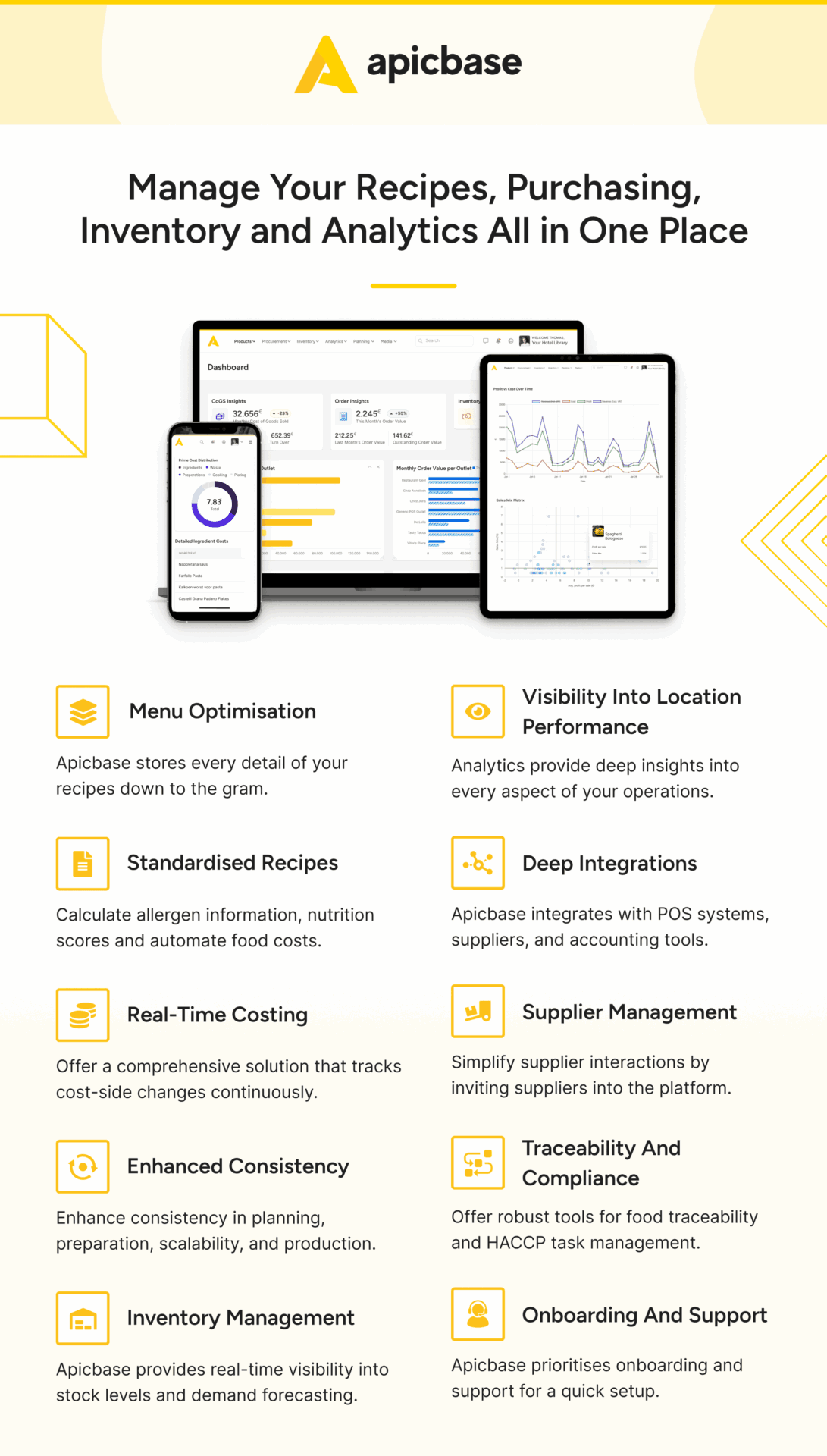
Menu optimisation
Effective menu creation and optimisation start with robust recipe management. Apicbase stores every detail of your recipes down to the gram. It allows you to make changes and see their effects in real-time, so you can tweak your dishes to create the best menu possible.
Executive chefs and menu developers can be creative while also seeing the effects different ingredients and quantities have on food costs, profit margins, allergen occurrence and carbon footprint.
When all data is stored in one place, everyone can access the same information, enabling collaboration to create profitable and popular dishes. New or updated recipes can be instantly made available to all outlets, ensuring consistency and efficiency.
Standardised recipes
Having a single source of truth for your recipes eliminates doubt about ingredients, suppliers, portion sizes, or allergens. This certainty aids production teams, whether they are preparing the same dishes in different kitchens or new employees still learning the menu, to create consistent dishes that cost what they are supposed to.
Apicbase automatically calculates allergen information and nutrition scores and automates food cost calculations, allowing your chefs to focus on cooking.
Real-time costing
Understanding the real-time costs of your menu items is crucial for maintaining profitability, especially in this competitive industry. Apicbase offers a comprehensive solution that tracks cost-side changes continuously, ensuring that you are always aware of how ingredient price fluctuations impact your menu costs.
With real-time recipe and menu cost calculation, you can make informed decisions quickly and adjust your pricing strategies accordingly. This proactive approach not only helps in safeguarding your margins but also in optimising your menus based on the latest pricing information.
Enhanced consistency
Consistency is key to building a reliable brand and guaranteeing customer satisfaction. A comprehensive platform like Apicbase enhances consistency in production planning, food preparation, scalability, and production processes. By creating scalable recipes with reliable yields, it ensures each dish is prepared to the same standard, no matter the location and scale.
This is particularly important for multi-unit operations where maintaining uniform quality can be challenging.
The production planning tools in Apicbase streamline processes by aggregating recipes and bills of materials. This makes it easier for your team to deliver consistent results every time.
Inventory management
Effective inventory management is essential for ensuring stock availability, reducing waste, controlling costs, and keeping your restaurant running smoothly. Inventory management software automates many manual tasks associated with inventory tracking.
By providing real-time visibility into stock levels and demand forecasting, Apicbase helps prevent overstocking and shortages. Automation of inventory processes reduces time spent on manual counts and provides more accurate data for making informed purchasing decisions.
Visibility into location performance
Managers in multi-unit restaurant businesses need real-time transparency about location performance, food costs, and other critical metrics. Apicbase’s advanced restaurant analytics provide deep insights into every aspect of your operations.
From sales trends to ingredient usage, the platform aggregates data into actionable insights that can be accessed from one dashboard. This level of visibility allows you to monitor performance across all locations, identify areas for improvement, and implement any necessary changes quickly, for maximum impact.
Deep integrations
A truly streamlined tech stack not only improves restaurant back-of-house operations but also ensures seamless communication with the front-of-house.
Apicbase offers deep integrations with a variety of POS systems, supplier databases, and accounting tools, making it easier to coordinate all aspects of your restaurant operations.
Through robust API capabilities, Apicbase enables custom integrations with your existing software solutions, allowing for a tailored and adaptable workflow. Apicbase integrates everything into one efficient tech ecosystem.
Supplier management
In a small independent restaurant, phoning two or three orders a night to a few suppliers is an adequate system. But for larger operations, supplier management becomes a task of its own. Effective management of purchasing becomes essential for maintaining a steady flow of ingredients and keeping costs under control.
Apicbase simplifies supplier interactions by inviting suppliers into the platform. This enables end-to-end supply chain management from procurement to inventory. A single supplier management dashboard allows for better order tracking, streamlined communication, and automated procurement processes.
By consolidating all supplier information and activities in one place, Apicbase helps you build stronger relationships with your suppliers and ensures that your supply chain operates smoothly with minimal errors.
Traceability and compliance
Food safety and compliance with health and safety regulations are top priorities for any responsible restaurant. Food traceability is all the more important when dealing with complex supply chains in larger businesses.
A centralised platform like Apicbase offers robust tools for food traceability and HACCP task management, making it easier to monitor and document every step of the food production process. This level of monitoring helps you quickly address any issues that arise and ensures compliance with regulatory standards, protecting both your business and your customers.
Onboarding and support
The food service industry suffers from high employee turnover. This makes quick and effective onboarding essential to hitting the ground running with new tech systems. Without the right support, you won’t get the return on investment you’re looking for with your new tech tools.
Apicbase prioritises onboarding and support to ensure your teams get up to speed quickly. The dedicated support team is available to assist with any issues, providing peace of mind that help is always at hand. This focus on onboarding and ongoing support helps your team leverage the full potential of Apicbase, ensuring a smooth transition from older systems and continuous improvement going forward.
Take Control of Your Multi-Site Operations
A single platform with all the back-of-house functions you need is the best way to manage complex multi-site restaurant operations. A cloud platform that has deep integrations with other systems solves the key challenges we discussed above.
Apicbase has been designed to be a comprehensive restaurant management platform, complete with the integrations, top-quality support, and key features and tools required.
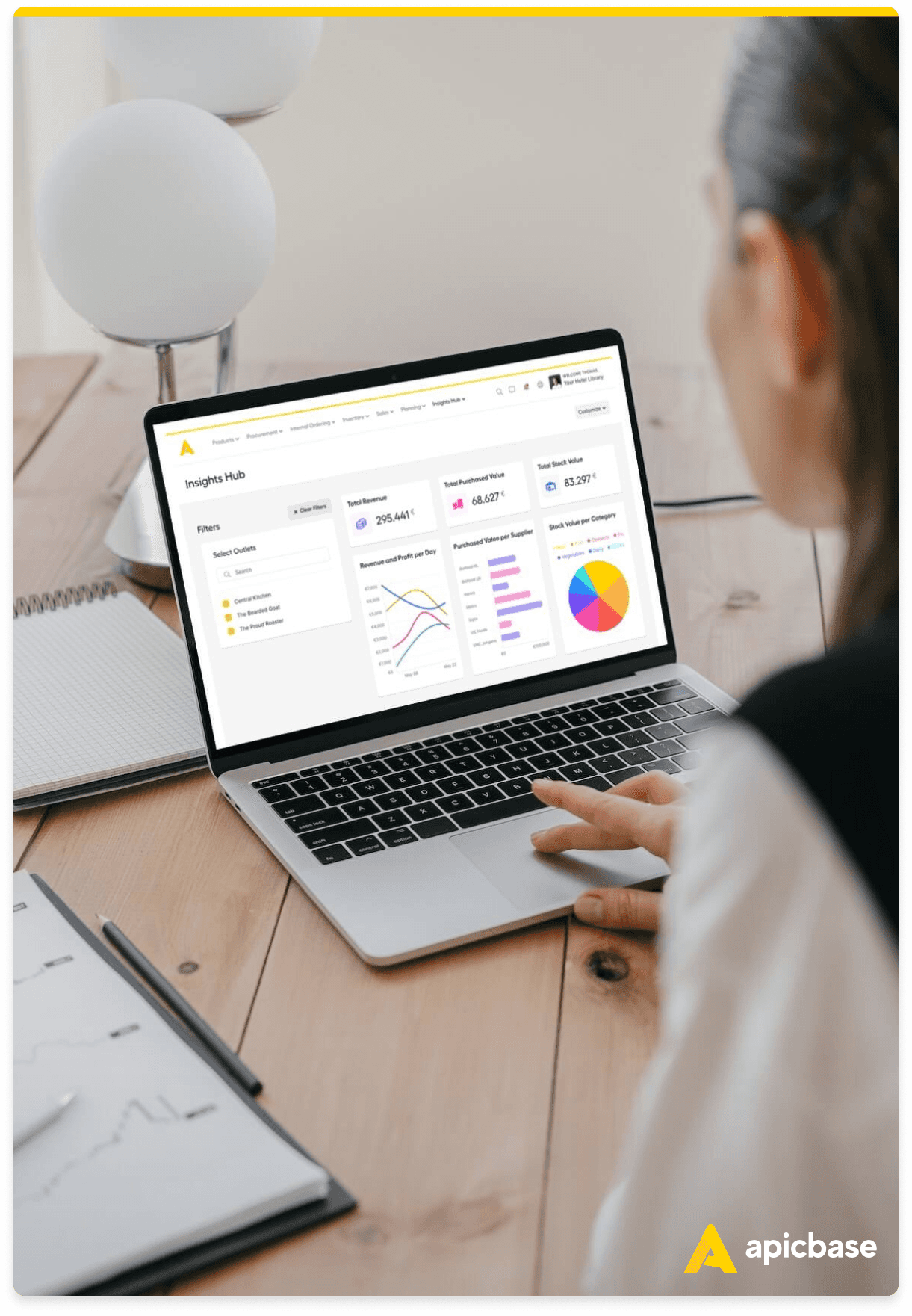
Discover the Power of Apicbase Today
Apicbase is the best choice for multi-unit or complex foodservice operations looking to reduce food costs, gain real-time insights from their data, and improve profit margins on every menu.

